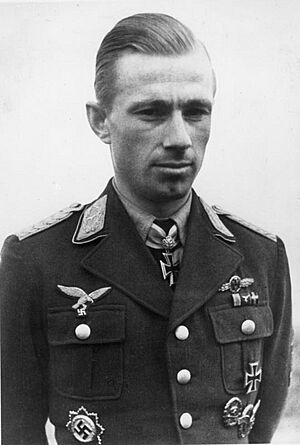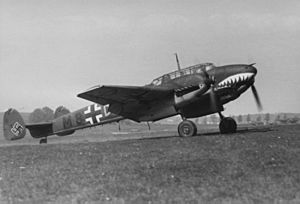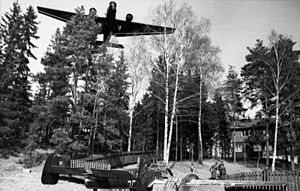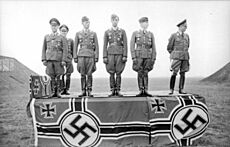Helmut Lent facts for kids
Quick facts for kids
Helmut Lent
|
|
|---|---|

Helmut Lent in 1943
|
|
| Born | 13 June 1918 Pyrehne, Kingdom of Prussia, German Empire |
| Died | 7 October 1944 (aged 26) Paderborn, Free State of Prussia, Nazi Germany |
| Buried |
Military cemetery at Stade
|
| Allegiance | |
| Service/ |
|
| Years of service | 1936–1944 |
| Rank | Oberst (posthumous) |
| Unit | ZG 76, NJG 1, NJG 2, NJG 3 |
| Commands held | IV./NJG 1, II./NJG 2, NJG 3 |
| Battles/wars |
See battles
|
| Awards | Knight's Cross of the Iron Cross with Oak Leaves, Swords and Diamonds |
Helmut Lent (born June 13, 1918 – died October 7, 1944) was a German pilot during World War II. He was known as a "night-fighter ace." This means he was a very skilled pilot who shot down many enemy planes, especially at night.
Lent shot down 110 aircraft in total. An amazing 102 of these were during night missions. He came from a very religious family. From a young age, he loved flying gliders. Even though his father didn't want him to, he joined the German Air Force (the Luftwaffe) in 1936.
After his training, Lent joined a special unit called Zerstörergeschwader 76 (ZG 76). They flew twin-engine Messerschmitt Bf 110 fighter planes. He got his first victories at the start of World War II during the invasion of Poland. He also fought over the North Sea. During the Norwegian Campaign, he helped ground troops. Later, he moved to a new night-fighter unit called Nachtjagdgeschwader 1 (NJG 1).
Helmut Lent got his first night victory on May 12, 1941. By August 30, 1941, he had 22 victories and received the Knight's Cross of the Iron Cross. He kept getting more victories, which led to more promotions and awards. On June 15, 1944, he became the first night fighter pilot to reach 100 night victories. For this, he received the highest award, the Knight's Cross of the Iron Cross with Oak Leaves, Swords and Diamonds, on July 31, 1944.
Sadly, on October 5, 1944, Lent was flying a Junkers Ju 88 plane. He was on a normal flight from Stade to Nordborchen. As he was landing, one of the engines stopped working. The plane hit power lines and crashed. All four crew members were badly hurt. Three of them died soon after the crash. Lent passed away two days later, on October 7, 1944, from his injuries.
Contents
Early Life and Training
Helmut Lent was born on June 13, 1918, in a place called Pyrehne, which is now in Poland. His full name was Helmut Johannes Siegfried Lent. He was the fifth child in his family. His father, Johannes Lent, was a Lutheran minister. His mother was Marie Elisabeth. Helmut had two older brothers, Werner and Joachim, and two older sisters, Käthe and Ursula. His family was very religious. Both his brothers and grandfathers were also Lutheran ministers.
From 1924 to 1928, Helmut went to primary school in Pyrehne. After that, his father and oldest brother, Werner, taught him at home. They prepared him for the entrance exam to a secondary school in Landsberg. In February 1933, Helmut joined the Jungvolk, which was the junior part of the Hitler Youth. He was a youth leader and a flag-bearer for a while. He left the Jungvolk in 1935 to get ready for his graduation exam.
Helmut finished his exams when he was 17, on December 12, 1935. In February 1936, he joined the National Labor Service for eight weeks. On April 1, 1936, he joined the Luftwaffe as a cadet. He did this even though his father didn't want him to.
His military training started on April 6, 1936, at the 2nd Air Warfare School near Berlin. He took an oath of loyalty to the Nazi government on April 21, 1936. He began flight training on August 7, 1936. His first flight was in a Heinkel He 72 biplane. He flew his first solo flight on September 15, 1936, in a Focke-Wulf Fw 44. By then, he had already flown 63 times.
During his training, Lent also learned to drive motorcycles and cars. He had a car accident and broke his upper leg. This stopped him from flying for five months. But it didn't stop his classroom learning. On April 1, 1937, he became an ensign. By October 19, 1937, he finished his flight training and got his pilot's license. He earned his pilot's wings on November 15, 1937.
On March 1, 1938, he became a Second Lieutenant. By this time, he had flown 434 times in eight different types of planes. He had spent over 112 hours in the air, mostly flying during the day.
Joining the Heavy Fighter Unit
After his training, Helmut Lent went to the Heavy Bomber Crew School. He spent three months learning to be an observer. Before he finished, he was hit by a car. This caused a broken jaw, a concussion, and internal bleeding. On July 1, 1938, Lent joined the 3rd Group of Jagdgeschwader 132 (III./JG 132). He flew again on July 19, 1938, after his injuries.
In September, Lent's squadron moved to Großenhain near Dresden. They were getting ready for the takeover of Czechoslovakia. Lent flew several missions during this time. His unit then moved again to Rangsdorf. After the tension eased, Lent's unit started using the Messerschmitt Bf 108 Taifun plane. On November 1, 1938, his unit was renamed II./JG 141, and Lent joined the 6th Squadron.
On May 1, 1939, II./JG 141 became I./Zerstörergeschwader 76 (I./ZG 76). They moved to an airfield in Czechoslovakia. The group was getting new Messerschmitt Bf 110 planes. Lent flew the Bf 110 for the first time on June 7, 1939. He got his advanced pilot's certificate, which meant he was good at flying multi-engine aircraft. On August 14, 1939, he flew with his regular wireless operator, Walter Kubisch, for the first time. Before World War II began, on August 25, 1939, I./ZG 76 moved to an airfield near Breslau.
World War II Begins
World War II started on September 1, 1939, when German forces entered Poland. Helmut Lent, flying a Bf 110, took off early that morning. He was escorting Heinkel He 111 bombers on a mission over Kraków.
Fighting in Poland
Germany's plan for invading Poland was called Fall Weiss (Case White). It involved attacks from three directions at once. On September 1, 1939, Helmut Lent and his wireless operator, Kubisch, escorted bombers. These bombers attacked airfields in Kraków. On September 2, 1939, Lent shot down his first enemy plane of the war, a PZL P.11, near Łódź.
After this, the Bf 110s changed from escorting bombers to attacking targets on the ground. This was because the Polish Air Force was almost defeated. On September 5, Lent and Kubisch destroyed a twin-engine plane on the ground. On September 9, they destroyed another plane, a PZL P.24. On September 12, a Polish plane attacked Lent. It shot out his right engine, forcing him to land behind German lines. He flew five more missions in Poland, destroying one anti-aircraft battery.
For his actions in Poland, Lent received the Iron Cross 2nd Class on September 21, 1939. His unit then moved to the Stuttgart area to defend against French and British forces. From October to December, I./ZG 76 operated from different airfields. Then, on December 16, 1939, they moved north to Jever.
Battle of the Heligoland Bight
In the first month of the war, the British Royal Air Force (RAF) mainly attacked German ships. On December 18, 1939, RAF bombers launched a big attack near Wilhelmshaven. This became known as the Battle of the Heligoland Bight. Twenty-four Vickers Wellington bombers flew towards the island of Heligoland. Two planes turned back, but 22 continued. A German radar spotted them.
Helmut Lent was ordered to stop the bombers. He had just landed and refueled. He claimed to have shot down three Wellingtons. Two of these, shot down at 2:30 PM and 2:45 PM, were later confirmed. These two planes were from No. 37 Squadron and crashed into the sea. His third claim might have been another Wellington that crash-landed. Lent was not given credit for one victory because another German pilot had already badly damaged the plane.
Lent's success as a fighter pilot made him a small national hero. His actions, like those at Heligoland, were good news for German propaganda. He started getting fan mail, mostly from young women. One of them was Elisabeth Petersen. Lent wrote back to her, and they met. They later went on a skiing holiday together.
Norway and the Battle of Britain
On April 8, 1940, eight planes from 1./ZG 76 moved north to Westerland in Germany. They were getting ready for Operation Weserübung, the Norwegian Campaign. Germany planned to attack the Norwegian capital, Oslo, and six major ports. At the same time, Junkers Ju 52 transport planes would drop paratroopers to take over Oslo's Fornebu airport. 1./ZG 76 was supposed to provide air cover and ground support.
Eight Bf 110 planes took off at 7:00 AM. They planned to arrive at Fornebu at the same time as the paratroopers. The flight was too long for a return trip. The pilots had enough fuel for 20 minutes over Fornebu, then they had to land once the airfield was captured.
On the flight to Fornebu, Lent fought and shot down a Norwegian Gloster Gladiator plane. As the Ju 52s carrying paratroopers came under heavy fire, Lent's team attacked enemy positions on the ground. Lent's right engine caught fire, forcing him to land right away. With Kubisch firing the machine gun, Lent helped negotiate the surrender with the Norwegian ground forces. The airfield was then in German hands.
Later that day, Lent and his squadron leader, Werner Hansen, took off again in undamaged Bf 110s. They found a RAF Short Sunderland flying boat and shot it down together. Hansen got credit for this victory. Helmut Lent received the Iron Cross 1st Class on May 13, 1940. He then moved to Trondheim on May 18. He claimed his second victory in Norway on May 27, shooting down a RAF Gloster Gladiator. On June 2, 1940, Lent and his wingman each claimed a Gladiator. He claimed his seventh victory overall, and his last in Norway, on June 15, 1940, over a Bristol Blenheim bomber. On July 1, 1940, Lent was promoted to First Lieutenant. On July 13, 1./ZG 76 moved to Stavanger/Forus.
Helmut Lent also briefly took part in the Battle of Britain. On August 15, 1940, his unit escorted He 111 bombers attacking targets in England. I./ZG 76 lost seven planes on this mission. This was Helmut Lent's 98th and final mission as a heavy fighter pilot.
Becoming a Night Fighter Ace
By June 1940, the RAF was flying more bombing missions into German airspace at night. So, the German Air Force decided to create a night-fighter force. Helmut Lent was not very excited about this at first. He wrote home, "We are currently changing to night fighting. We are not very enthusiastic. We would sooner head directly for England."
Lent completed his night fighter training. On October 1, 1940, he became the squadron leader of the new 6./NJG 1. This squadron was based in the Netherlands. On the night of May 11–12, 1941, Lent got his first two night victories. He shot down two Wellington bombers that were on a mission to Hamburg.
On July 1, 1941, he took command of 4./NJG 1. This unit was based in Leeuwarden, Netherlands. From here, the squadron patrolled the North Sea coast. They could intercept Allied night bombing missions. By the end of the war, 4./NJG 1 was one of the most successful night fighter squadrons. On August 30, 1941, Lent received the Knight's Cross of the Iron Cross for his 7 daytime and 14 night victories.
On November 1, 1941, Lent became the acting Group Commander of II./NJG 2. On October 1, 1942, this unit was renamed IV./NJG 1. Lent's first victory as a Group Commander was his 20th night-time victory. He shot down a Wellington bomber heading for Berlin. This achievement earned Lent a mention in the Wehrmachtbericht, which was a special honor.
Lent was promoted to Captain on January 1, 1942. Later that year, he received the Knight's Cross of the Iron Cross with Oak Leaves on June 6, 1942. By then, he had 34 night victories and 7 daytime victories. He also made history by achieving the first air victory using Lichtenstein radar in a Dornier Do 215B-5 night fighter. Lent often flew this plane for long missions. He claimed at least four victories in it.
By the end of 1942, Lent had 56 victories and was the top German night-fighter ace. He was promoted to Major on January 1, 1943. On August 1, 1943, he became the Wing Commander of NJG 3. After 73 kills (65 at night), he received the Knight's Cross of the Iron Cross with Oak Leaves and Swords on August 2, 1943.
In January 1944, Lent shot down three large four-engine bombers in one night. His plane was damaged, and he had to make an emergency landing. He was very efficient, sometimes using very few cannon shells to shoot down planes. For example, he used only 22 shells to down two bombers on March 22–23, 1944. He fired only 57 rounds in seven minutes against three Avro Lancasters on June 15–16. He was promoted to Lieutenant Colonel. He received the Knight's Cross of the Iron Cross with Oak Leaves, Swords and Diamonds for his 110 confirmed air kills. He was the first of only two night-fighter pilots to get this award. The other was Heinz-Wolfgang Schnaufer, who became the top night-fighter pilot with 121 victories.
Personal Life
German officers needed official permission to marry. When Lent decided to marry Elisabeth Petersen, it was a bit complicated. Her real name was Helene (Lena) Senokosnikova, and she was born in Moscow. She was afraid to tell her true identity because Russians were not popular in Nazi Germany. After a detailed check of her background, she became a German citizen on March 15, 1941. They married on September 10, 1941, in Hamburg. They had two daughters. Christina was born on June 6, 1942. Their second daughter, Helma, was born on October 6, 1944, right after her father's fatal crash.
Helmut's older brothers, Joachim and Werner, were part of the Confessing Church. This was a group within German Protestantism that opposed the Nazi government's efforts to control the churches. Werner Lent was arrested in 1937 for preaching against the Nazis. In June 1942, his brother Joachim was arrested by the Gestapo. This happened after he read a letter from the pulpit. This letter, which was actually British propaganda, suggested that a famous German pilot, Werner Mölders, valued his Catholic faith more than his loyalty to the Nazi Party.
Death and Legacy

On October 5, 1944, Lent was flying his Junkers Ju 88 plane from Stade to Paderborn. His crew included his long-time radio operator Walter Kubisch. Also on board were Werner Kark, an aerial gunner, and Hermann Klöss, a second radio operator. Lent was going to meet another commander to talk about missions. Shortly before they arrived, the Paderborn airfield had been attacked by American planes, leaving holes on the runway.
An emergency runway was quickly set up for Lent. However, an overhead electrical cable was missed. As the plane was landing, the left engine failed, causing the wing to drop. Lent could not keep the plane steady, and it hit high-voltage cables and crashed. All four crew members were badly injured but were alive. Kubisch and Klöss died the same day. Kark died the next morning. Helmut Lent himself died two days later, on October 7, 1944.
Lent's state funeral was held in Berlin on October 11, 1944. Hermann Göring, a high-ranking Nazi official, saluted Lent's coffin. Six officers, all winners of the Knight's Cross, guarded the coffin. On October 12, 1944, Lent and his crew were buried together in a single grave at the military cemetery in Stade.
Remembering Helmut Lent
Some of Helmut Lent's awards were sold at an auction in London in 1966. They were bought by Adolf Galland, a former German general, on behalf of the West German Ministry of Defence. Lent's elder daughter, Christina, sold the awards because her mother, Lena, needed money for an operation. The Ministry of Defence then gave the collection to a military history museum in Germany.
In 1964, a German Army base in Rotenburg was named the Lent Barracks. This was suggested by Lent's former superior. However, in 2014, the German military (the Bundeswehr) decided to rename the base. They felt that Lent was no longer a suitable namesake. This decision was made because of modern ideas about military tradition. The Bundeswehr decided that they should not honor people who acted in a criminal, racist, or inhumane way. On June 8, 2020, the barracks was officially renamed the Von-Düring Barracks.
Career Summary
Helmut Lent is officially credited with 111 victories in 507 flights. This includes 103 victories at night. During these night missions, he destroyed 59 four-engine bombers and one de Havilland Mosquito, among other types of planes. Lent was promoted to Colonel after his death.
Awards and Promotions
Helmut Lent received many awards during his career:
- Pilot's Badge (November 15, 1937)
- Sudetenland Medal
- Narvik Shield (January 30, 1941)
- Wound Badge
- in Black (July 14, 1941)
- in Silver (December 22, 1943)
- Iron Cross
- 2nd class (September 21, 1939)
- 1st class (May 11, 1940)
- Honour Goblet of the Luftwaffe (June 26, 1941)
- Front Flying Clasp of the Luftwaffe for Destroyer Pilots in Gold
- Front Flying Clasp of the Luftwaffe for Nightfighter Pilots in Gold with Pennant "300"
- Combined Pilots-Observation Badge in Gold with Diamonds
- German Cross in Gold (April 9, 1942)
- Knight's Cross of the Iron Cross with Oak Leaves, Swords and Diamonds
- Knight's Cross (August 30, 1941)
- 98th Oak Leaves (June 6, 1942)
- 32nd Swords (August 2, 1943)
- 15th Diamonds (July 31, 1944)
He also received several promotions:
- April 1, 1936: Cadet
- April 1, 1937: Ensign
- February 1, 1938: Senior Ensign
- March 1, 1938: Second Lieutenant
- July 1, 1940: First Lieutenant
- January 1, 1942: Captain
- January 1, 1943: Major
- March 1, 1944: Lieutenant Colonel
- Posthumously: Colonel








